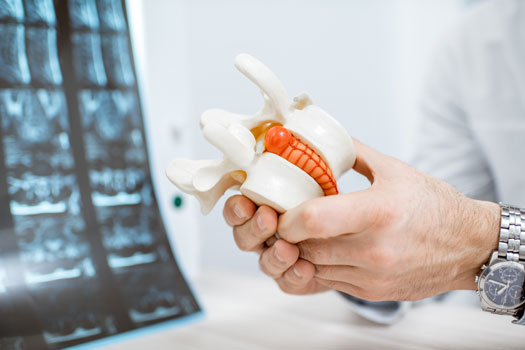
If you're wondering why you're having tingling sensations around your hip/upper leg area when you get up or make certain movements, you may have issues with a herniated disc. This type of damage can affect any part of the spine, but it's more likely to affect the lower back region. Below, we go over the basics of herniated discs and what can be done to prevent this source of spine-related aches and pains.
Defining Disc Herniation
A spinal disc is a soft structure that cushions vertebrae and support’s your body’s weight. It has a jelly-like interior and a tougher exterior surface. The purpose of a spinal disc is to ease friction and stress from movements. A disc becomes "herniated" if the inner material pushes outward enough to irritate nearby nerves.
Identifying Disc-Related Problems
The symptoms you'll notice with a herniated disc are dependent on how a nearby nerve is affected and the location of the problem disc. Therefore, discomfort is likely to be more noticeable in areas along the irritated nerve's pathway. Symptoms commonly associated with a herniated disc include:
• Discomfort that shoots along the nerve's pathway when you cough or move
• General weakness affecting the muscles served by the affected nerve
• Numbness or tingling sensations that sometimes worsen when in certain positions
• Arm or shoulder pain if a disc in your neck is affected
• Pain radiating to your buttocks, hips, thighs, or upper legs if a lower back disc is affected
Herniated Disc Causes
As for what causes a herniated disc, the most common cause is disc damage related to age-related wear. Spinal discs naturally become less hydrated over time and lose flexibility, which further increases the risk of rupture and similar types of damage. In some instances, sudden trauma or placing too much stress on certain areas of your spine can cause a disc herniation.
Preventing Herniated Discs
Drinking plenty of water or other healthy liquids is one way to keep your spinal discs healthy to reduce the risk of disc herniation. Getting regular exercise is also helpful, since this strengthens the muscle groups that ease pressure on the spine and its discs. Your spinal discs will also be less likely to become seriously damaged with:
• The use of proper lifting techniques
• Efforts to maintain a healthy weight
• Proper posture when you're sitting and standing
Diagnosing a Herniated Disc
A physical exam is usually what's done first to determine if you may have a herniated disc. The confirmation typically comes from diagnostic tests that often include X-rays, CT scans, MRIs, and/or nerve conduction studies. Dye may also be injected into spinal fluid before X-rays are taken to identify areas where there's spinal cord or nerve pressure.
Treating Spinal Disc Issues
Unless the damage is severe and your symptoms are potentially life-threatening, treatment for a herniated disc usually involves nonsurgical options. These typically include:
• Prescription or over-the-counter medications
• Cortisone/steroid injections
• Physical therapy exercises
• Massage therapy
If conservative treatments aren't effective for your herniated disc, surgery may be recommended. The main purpose of surgery is to relieve pressure on the irritated or compressed nerve. The most common surgery is discectomy, when the surgeon reaches the damaged disc from the back of the spine through the muscles and bone.
Although discectomy surgery is generally a very successful procedure, patients with a larger hole in the outer ring of the disc have a significantly higher risk for herniation following surgery. Often, the surgeon won’t know the size of the whole until he or she begins surgery. A new treatment, Barricaid, which is a bone-anchored device proven to reduce reherniations, was specifically designed to close the large hole often left in the spinal disc after discectomy. In a large-scale study, Barricaid was proven 95 percent effective. This means 95 percent of patients didn’t experience a reoperation due to reherniation in the 2-year study timeframe.
If you have any questions about the Barricaid treatment or how to get access to Barricaid, ask your doctor or contact us at 844-288-7474.
For full benefit/risk information, please visit: https://www.barricaid.com/instructions.


Comments